I intend this post to apply to lots of other hiking destinations, but at least it should improve your experience and expectations on this iconic walk. ‘You live and learn – or you don’t live long’ – as the man said (ie Lazarus Long, ‘Time Enough For Love’).
I have lived long, and intend to live even longer. In contrast, both times I undertook the EBC I witnessed dead bodies being unloaded from helicopters! I also saw many folks much younger than myself getting themselves into serious difficulties which might well have led to just the same outcomes if I had hung around being a fly on their walls. I have seen young folks dead many times before. Don’t let that be you!
Setting out from Lukla:
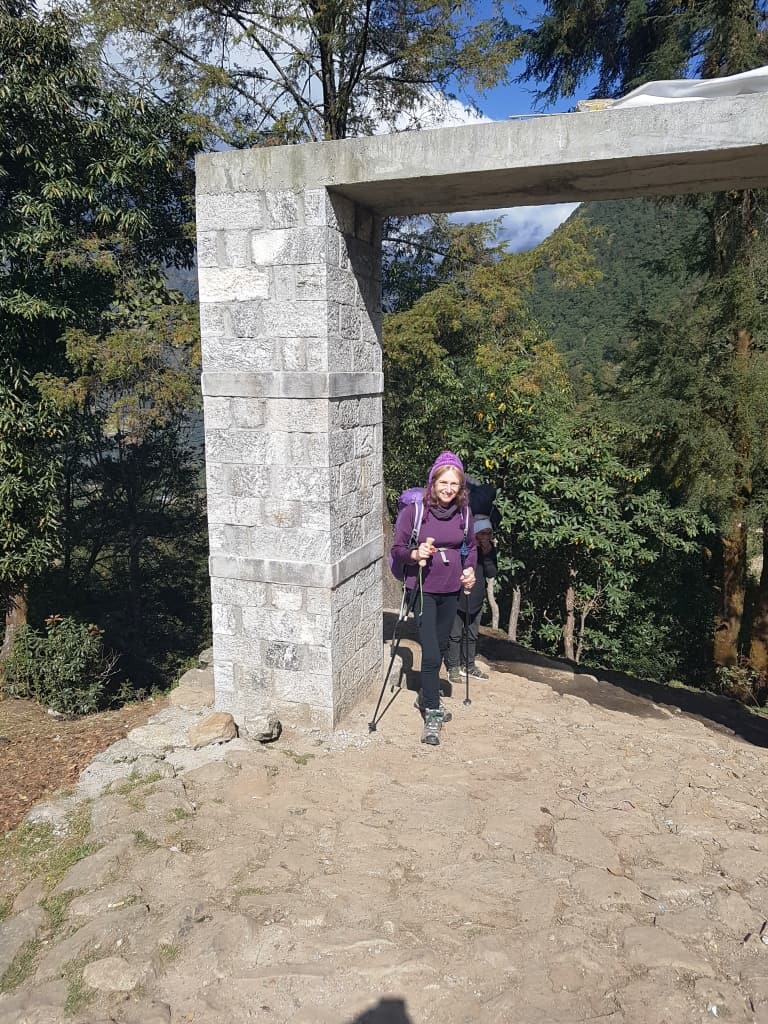
Should you carry your own gear &/or should you employ a guide? If you are into ‘virtue signalling’ – as about half the population seems to be nowadays, (Myself – as Red said – ‘I couldn’t give a damn!’) you will have lots of reasons why you should employ someone else. Delegate responsibility for your life to someone else if you don’t value it overmuch. Myself I value my own hide too highly to trust someone else with its responsibility.
Crows will be into your pack if you leave it unattended:
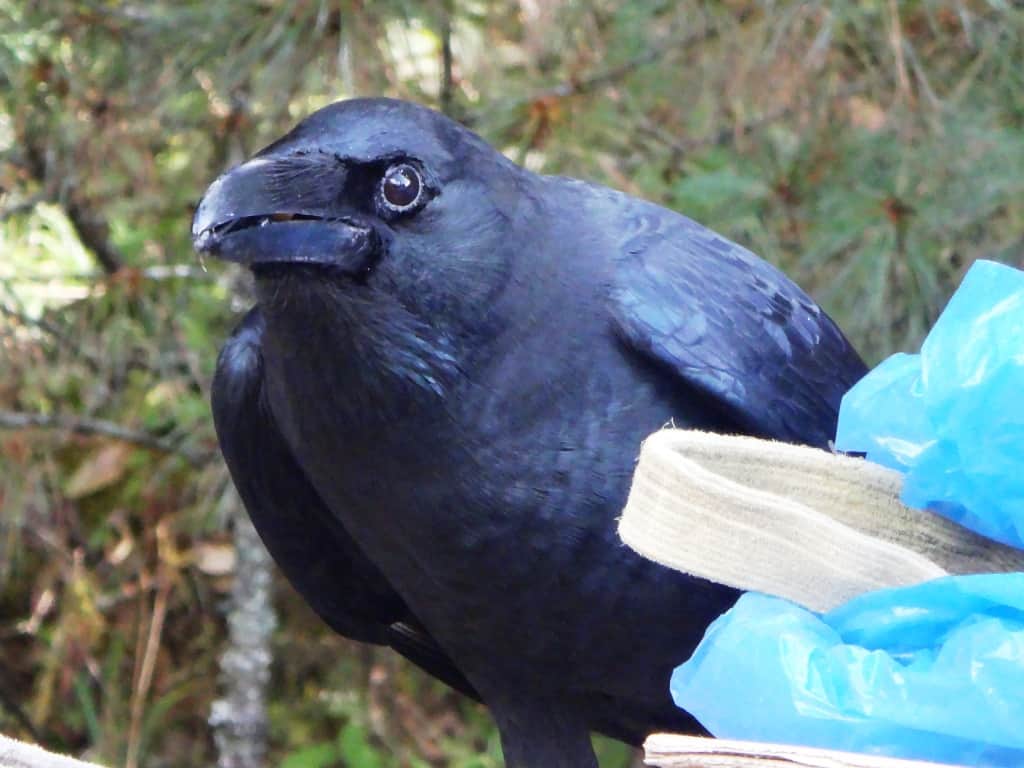
If you want that important piece of gear (without which you are just a frozen corpse) when you need it, best make sure it is in the pack on your own back, not perhaps many miles away on someone else’s, no matter how much more comfortable that may seem to be. Most people on the trail had off-loaded everything (looked like the kitchen sink too) onto someone else. Certainly all the (few) older people such as ourselves had. I have direct experience on both trips of numbers of folk who regretted it!
About that Pack: We both took the Amazon packs I wrote about back here with some further mods I will detail later. The packs each weighed around 350 grams (for 40 litres – quite enough!) Della’s cost A$10.90 from Amazon. She bought four so she would never run out! She likes purple! Fully loaded they weighed 6-7 kg at most.
Della loves that purple pack:
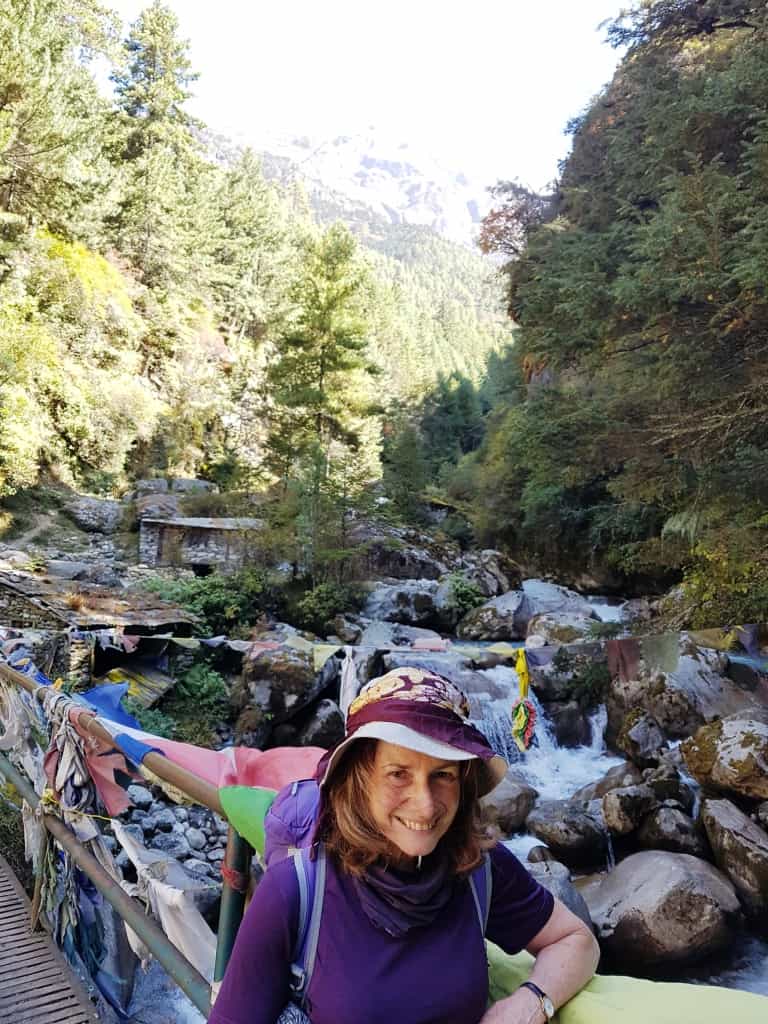
Aside: I have discovered that hip belts are in the wrong place (ie not at the waist – your narrowest part) and should not weigh more than 12 grams (including clip/buckle) and should be sewn on to the pack only at the middle (approx) six inches of your back – so they do up all around your waist. The belt will then cinch up comfortably all around your waist, your narrowest part, making it impossible for your pack to move down from the small of your back, and so its weight will be supported by your bum instead of your shoulders even though the waist belt (and shoulder straps) are quite loose as they should be – by comparison with whatever you are doing now. More about this later…
The Sit Light Air Pad attached as shown in the above post will give you a dry back too. I will minimise this pack design further – by trimming the pad. A tough (eg Dyneema and approx 50 litre) multi-day hiking pack ought not weigh more than 400 grams. If yours does, you are just wrong, wrong, wrong!
I have further decided that you ought not need a hip/waist belt or a chest belt at all if the pack is well-designed (which I suspect none are!) and not too heavy – shouldn’t be. These extra straps and other gee-gaws just restrict your body’s natural walking movement and rhythm and tire you out unnecessarily without adding one jot of comfort! As I said, more about this later….
The way ahead:

Shelter? I would always carry an emergency shelter/tent anywhere you might get caught outside in the rain/wind/snow, ie practically everywhere. Most places I go I usually carry one of my ultralight DIY tents or a hammock and fly (or sometimes both – my new tarp doubles). Even on day trips I will have a space blanket bag or poncho. Just something to save your life if you get caught out – yet I am proficient at constructing emergency shelters from found materials and lighting fires in the wet – are you?
Of course I would recommend that like most that you visit the EBC at the most (weather) opportune time (late Oct-Early Nov for example). Temperatures, wind and precipitation are then at their best. Even so (just like anywhere) disastrous ‘weather’ can strike – and don’t forget the awful earthquake of just a few years back (which flattened whole towns – Think Thame) where you may have been intending to stay!
People have put considerable thought into the design of these ultralight shelters (which are not dependent on soft ground (not much of it around on the EBC) to drive tent pegs into). This one (from Terra Nova, for example) weighs only 253 grams (for two). I took my old one which is 100 grams heavier (because we are not made of money), but you get the point.
In an emergency both of us could cram into this shelter, inflate our mats (good to ‘Comfort’ at -10-20C), climb into our -10-20C sleeping bags (plus all our down clothes) and ‘enjoy’ a safe night out in the most extreme conditions if necessary. You just don’t know when/whether such an emergency will occur. Be warned: the ground is often frozen, or nearly so!
I already mentioned earthquakes. Everywhere on the trail there is evidence of (immense) earlier landslides. (There are warning signs everywhere that) glacial lakes can burst and cause inundations which would sweep whole villages away. You might simply lose the trail, be beaten by darkness arriving earlier than you expected, be sick, twist your ankle and be unable to complete your day’s journey, and so on…Prepare for the worst and be grateful when it does not occur. Even after a lifetime of experience in the bush we can sometimes be caught out. But we are always prepared, and almost always enjoy ourselves whatever happens!
First view of Everest as you ascend the Namche Hill:
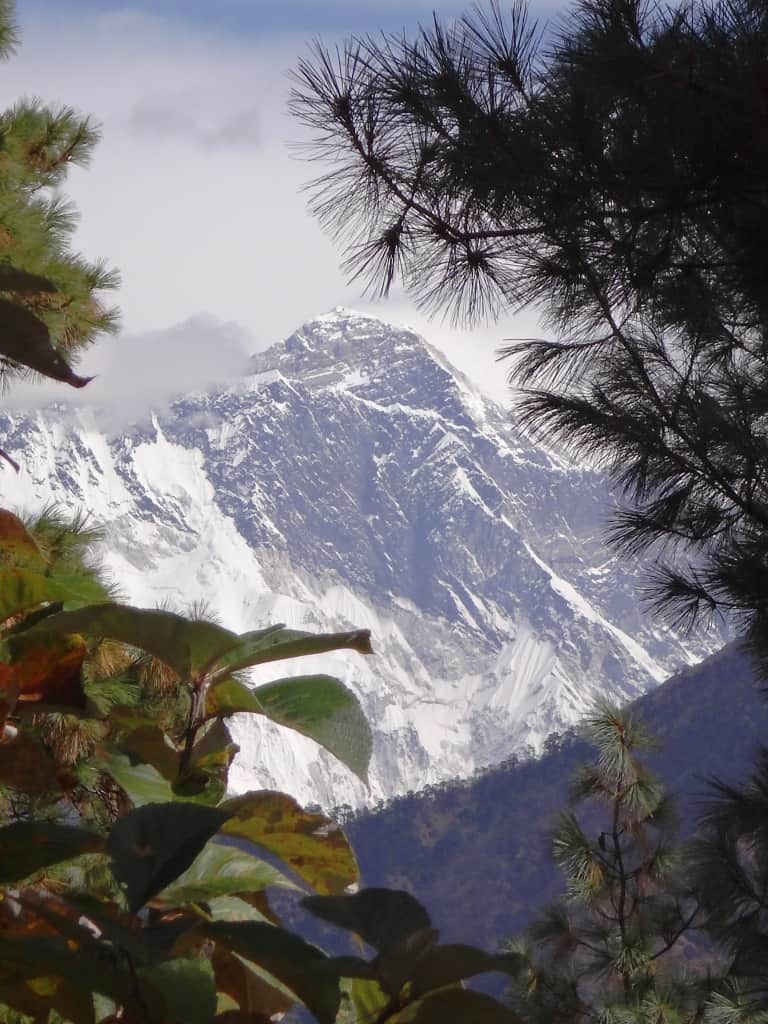
Sleeping? Should you take an insulated mat and sleeping bag? Again, if you want to live – and this survival equipment should be on your person at all times. Wherever you are, go nowhere without your pack (and its essentials). Many (inexperienced) folk meet with disaster because they put their pack down on a trail just to step off it a few metres eg to answer a ‘call of nature’, an interesting euphemism.
Separated from their pack and alone in the wilderness…not long before things can start to really unwind! Not everyone has the ability eg to lose one of their hearing aids yet be able to backtrack themselves through several hours of the trackless bush until they find it. Our mats weigh just under 400 grams each, and our (warmest) sleeping bags around 800 grams.
You need a mat anyway even when staying in tea/guest houses and ‘hotels. Particularly as you travel higher up the (provided) mattresses will ‘strike’ colder and colder. Probably this is because of condensation which has not had a chance to evaporate away (actually at this altitude water/ice does not evaporate; it ‘sublimes’ – there’s a new use of that word for you). If your body (heat) is trying to warm up (perhaps several kilos) of sub zero ice/water in your (quite likely uncomfortable) mattress, it will not matter if you have a minus 100C sleeping bag; you will be cold! An ultralight inflatable mat such as the Thermarest NeoAir X-Lite Women’s, or X-Therm or the superb Exped Synmat with its nearly 4″ thickness of comfort will ensure you have a warm, comfortable night’s sleep. The importance of this cannot be exaggerated too much!
Rain Gear? Yes, it might rain/snow etc, though it is unlikely at this time of year, but you never know. We carried both coats, pants, gaiters and waterproof shoes, though I (but not Della) usually do not bother with more than just a coat. Adipose is good insulation! If you get wet at this altitude (and night-time temperature/s) you are likely to be miserable (at best). Frostbite is not much fun either. We did not need them, but an extra layer is good insurance. We are looking at something like 300 grams (each) for the three waterproof clothing items (plus a bit for Keen Targhees instead of Voyageurs). Safety first.
Food and Water. You really don’t need to carry either. There is somewhere you can buy either every few hundred yards on average, though there are some longer sections where you might get a bit thirsty if you started out without a full water bottle – climbing the hill up to Tengboche for example on a warm day. ‘Safe’ bottled water is available from (approx) US$1-2 per litre. We also carried a Sawyer Mini filter and squeeze bottle in case we needed to drink from other sources, etc. This is just sensible insurance.
You will inevitably meet with (very ill) folks who think they can (safely) drink the water or that water purification tabs ( iodine etc) work. There is one born every minute. Disinfection takes time (more than an hour) and only removes a handful of the pathogens which your Sawyer with <1 micron filter) automatically removes. It can/should regularly be backflushed like this (2 grams) . Filter (60 grams) plus squeeze bottle (approx 20 grams). Worth it for safety. In an emergency supplies of potable water will dry up fast!
NB: Do not clean your teeth or wash you mouth out with the water. Also carry antiseptic wipes (or similar) and use them religiously. There are lots of invisible nasties you do not want to succumb to. Do not pat animals! Do not put used toilet paper or (particularly) wipes in the toilet. There is a basket provided for that purpose . The septic tanks they have will not cope and will block up.
Medicines: When you contract diarrhea from bad water/food you will need Imodium and probably Stemetil for vomiting. If it persists (Typhoid perhaps?) you will need Cipro (antibiotic). It has saved my life! (from Pneumonia) I gave some of my supplies to a young British backpacker at the bottom of the hill at Tengboche. He was leaking badly at both ends. His guide was completely unprepared (common) and insisted he continue (to gain altitude) when his symptoms (I was trying to alleviate) might well prove to be the beginning of altitude sickness as well – in which case he needed to descend (fast!) or maybe die! Be warned! I hope he survived.
Apart from Diamox to prevent/treat altitude sickness, You should also have a prescription for Erithromycin and Azithromycin for pneumonia.
There is a pharmacy in Namche and also one at the French Bakery/Snow Lions in Dingboche where you can obtain these things. There is a small hospital in Pariche (near Dingboche). Your first aid kit should also contain blister pads – you will likely need them!
I suggest you do not eat meat after you leave Lukla. Even in Lukla not everyone has a (working) refrigerator. Animals cannot be slaughtered within the National Park so all meat is carried in on someone’s back (perhaps in the hot sun for days)! Eggs or beans are good alternative protein. Food poisoning is not much holiday fun really. Be warned!
You can buy Snickers/Mars/ Bounty bars pretty much everywhere (US$1-2). Most/all of the food on the trail is just absolutely awful. I would never pay for such food anywhere else. Expect to lose weight! There is very little variety, but even with the few ingredients they mysteriously seem to be able to grow/carry in Della or I could make many delicious meals. Instead expect every meal to lean towards inedibility. It is possible too that you may not like oily.
If you carry your own food in (or decide to eat elsewhere than where you are staying) your accommodation costs will be bumped up – and the quality of the food will not be very different. The Dal Bhat, Momos ‘Tuna Burgers’ and fried eggs on chips appear to be about the height of fine dining Nepali style. I could just about choke down two slices of ‘toast’ with ‘butter’ and honey for breakfast. If you are a ‘coffee snob’ forget it! They do sell sore throat lollies practically everywhere. You will likely need them. If you have a preference maybe bring your own. Butter Menthols are great (and Werthers caramels – you will lust after these before you return to Australia. You can buy them in Kathmandu airport!)
Do look forward to having ‘Black Forest Cake’ at Hermen’s Bakery (Northern outskirts of Phakding). It will not be anything like Black Forest Cake, but it will probably be the best thing you eat on the trip. You would not look at it elsewhere. (Tip: When you are back in Kathmandu, do try the Yak and Yeti restaurant – in an old palace. Expensive, but you may need to reward yourself Our thanks to Guillaume Maurel of Maurituius for a memorable night).
Lots of people (most?) get diarrhea or pneumonia (or both) above Dingboche. And of course Altitude Sickness. Lots of very expensive helicopter evacuations. There is also much less accommodation. You may (even/likely) end up sleeping on the (forzen) floor – where you really wish you had that minus 20C mat! One reason why Della and I decided before we left Australia that the Nagarshang Hill, Dingboche would be our destination. This is as high as Everest Base Camp but can be climbed on a pleasant sunny morning with tea and cake in the French Bakery Dingboche afterwards. (They also have rooms for rent with their own toilets!) Even in Dingboche all the water freezes overnight. Above that hardly anything thaws ot, so if you venture there be on the lookout (eg) or toiletry fiascos you had never imagined possible.
French Bakery Dingboche:

It has pretty much as good a view (of Everest, etc) as you are going to get elsewhere without venturing into the permanent sub-zero regions where there is not a single living thing to break the dismalness and monotony of the view. It will shorten your trip by 3-4 days too and enormously reduce the chances of your getting sick and/or dying.
View from the Hill, Dingboche: NB: Behind that grey hill on he left is just such a one of those glacial lakes perched up there held in pace only by scree and ready to let go and drown towns downstream like Phariche (below) immediately. Della os enjoying herself anyway. Steroids and being alive again, when last time I was there she was just so flat with he poor old heart (seemingly) all played out. She is good as new (almost) now – as you can see!

Altitude Sickness and Acclimatisation: Pay attention Everywhere we met (even fit young) people who had gone up the same day as us (or before) coming back down with Altitude Sickness, and looking very unhappy and worried. If you are going to enjoy the walk you must do everything you can too avoid this nemesis. You need to increase oxygen transfer in a much lower oxygen environment. Get a prescription from your doctor before you leave home for either Diamox or Dexamethasone (Steroid Della needed instead because of her heart condition – it seemed to work somewhat better).
Take the time to enjoy the donkeys:

And the yaks:
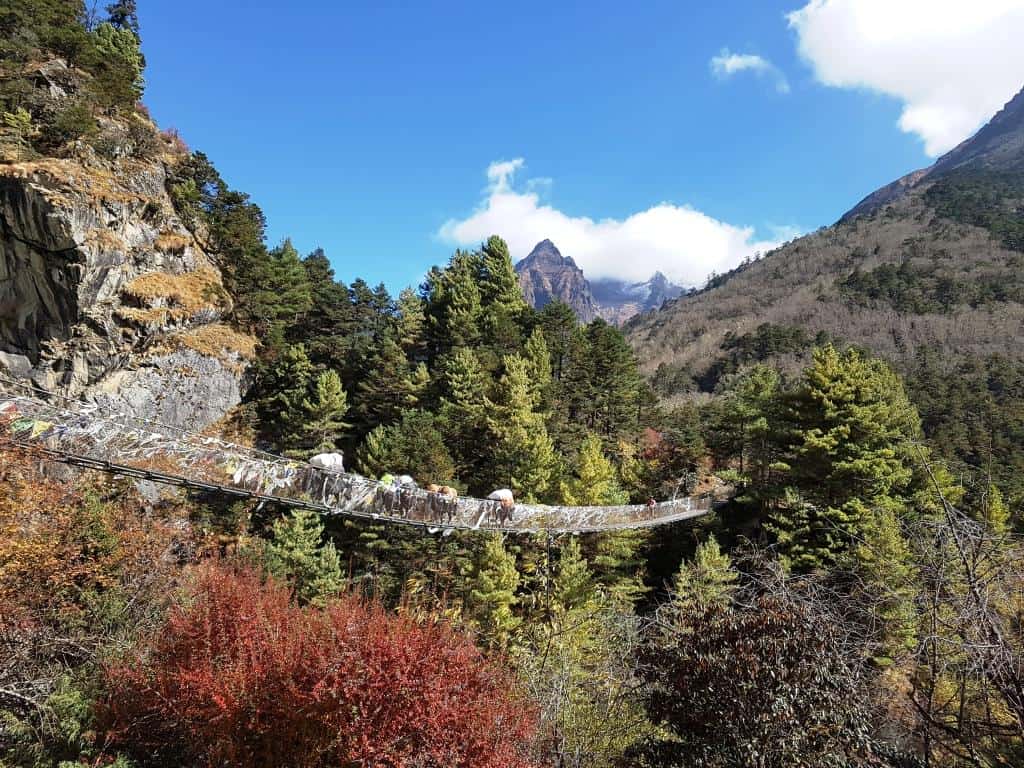
These guys were making heavy going of it:

I took half a tab of Diamox twice per day from when I was leaving Kathmandu to when I arrived back there. This was as a preventative. It is normally carried as a treatment for Altitude Sickness, but if you wait till you have symptoms it is too late for this trip: you will have to go down, fast!
You also need to take the time to acclimatise. If you don’t you will very likely get sick (and you can even die suddenly eg from an embolism! Be warned)! You will have come up from 1`400 metres at Kathmandu to 2900 metres at Lukla. That is quite enough stress for the body in one day. Stay the night in Lukla. Spend the day on some little acclimatisation walks around the town. For example, walk around the airport, or go down to the hydro plant in the valley below and back, climb up the hill above the town (past the army base and the school) into the wonderful rhododendron forests etc. Over 3,000 metres when you have ascendeded 500 metres you need a day to acclimatise. You can spend this day climbing higher so long as you sleep lower. You need an acclimatisatiion day at Namche and again at Dingboche.
Take a break in Namche:
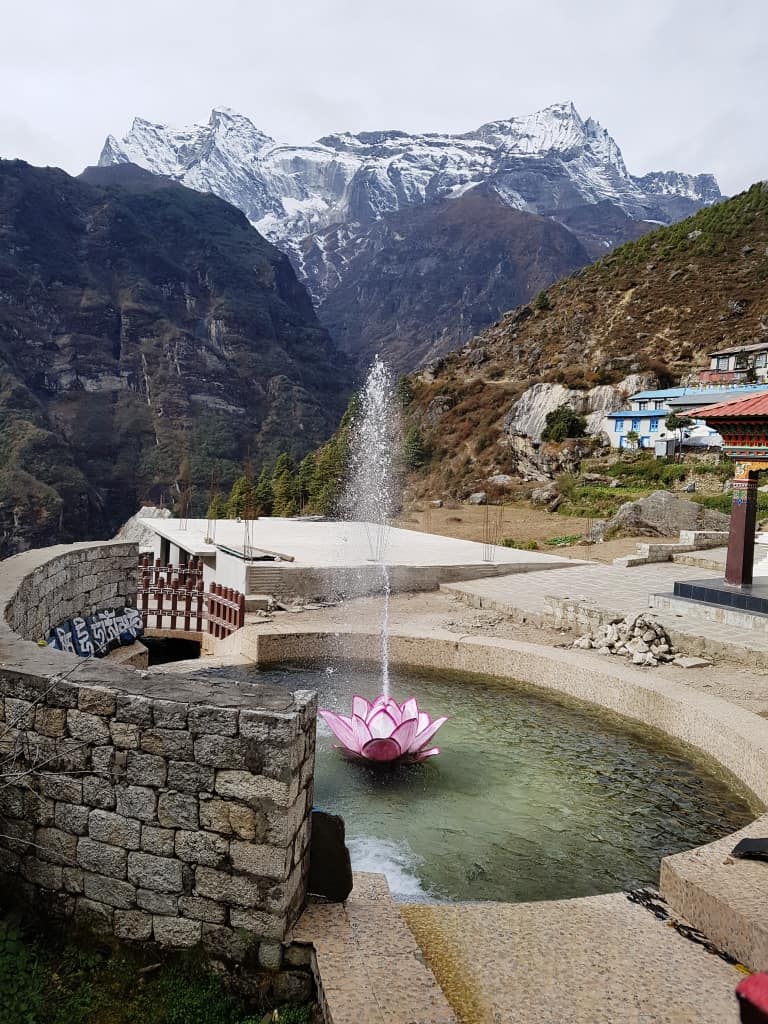
If you skip these days you are risking your life. All the people we saw who were sick from the altitude had skipped one of these pieces of advice – or both. It has probably cost you at least A$1500 just to get yourself to Lukla (return) plus insurance. It is foolish to just waste that investment.
You get a odd view of Everest during your acclimatisation day at Namche:
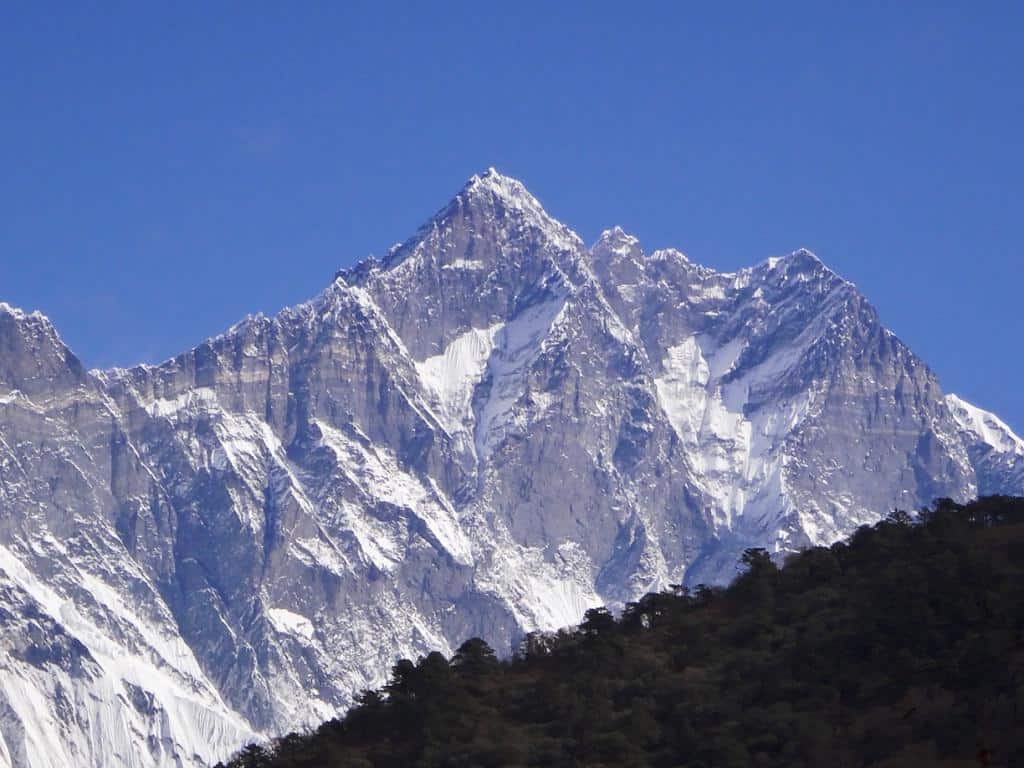
Vaccines? Yes you should. Everything available eg Triple Antigen, Hepatitus, Typhoid, Cholera… and Rabies? Yes. It is 100% fatal. look at the photo of Della (above) to see just how easy it would be to contract it by such an innocuous thing as feeding the monkeys! Get the best advice from your country’s foreign affairs department about what might be required in Nepal and have yourself protected against them all. There are quite enough other dangers as well. (Untreated) eg cholera can rob you of your entire body weight in fluid in a single day! That must be something to see, but I will eschew it! Doesn’t sound like much fun, does it? And it is preventable.
Don’t feed the monkeys:

More About Guides/Outfitters: I already stressed why we would determine to carry our own (at least essential) gear. In fact we carried all our own gear – but this only came to 5-6 kg each for a ten day trip! This is more than we would normally carry, because it was colder. We would normally begin a 10 day (unsupported) hike where we camped out the entire way with pack weights including food of well less than 10 kg each.
I would normally wash my clothes and dry them on a line across the back of my pack (and then in front of the night fire) on such a trip but this is not possible on the EBC because it is too dusty. In half an hour your clothes will be coated in mud! You can have your dirty clothes washed and dried (eg) in Namche and Dingboche during your rest days. This way you only need one change of clothes to be quite clean enough.
I have often enough gone for ten days at a time in the past without washing my (wool) clothing without becoming offensively smelly. Of course I usually go where there is no-one else about. There are lots and lots of people on the EBC. You have to wait for them all the time eg to cross bridges or at narrow points in the trail, or just because the large groups are just bloody rude and want to take up the whole width of the trail. There is no credo of ‘age before beauty’ amongst them I assure you! The donkeys and yaks are more polite, believe me. Still they should not be challenged for passage on bridges, and you should always pass them on the uphill side in case they accidentally bump you off.
The ‘give way’ rule in action:

No doubt there are competent guides and outfitters, but you really don’t need to spend the money. Nor do you have to pre-book the accommodation. You can just pretty much walk into any guest hose unannounced and there will be a vacancy – at least as far as Dingboche anyway. It is incredible just how much building has been going on there in the last three years since I was there before. Then you were lucky to see two helicopters a day but now there are usually 2-3 helicopters in the sky above you from dawn to dusk. Mostly they are ferrying building supplies up the valley. They are too impatient (etc) to wait for porters to carry the supplies up, so why should you feel guilty if you chose to carry your own (survival) gear? You will have to eat the food etc that the porters have carried up from Phaplu anyway.
The outfitters can add A$5-6,000 to a couple of weeks’ trek. You do not need them. Nor do you need guides. You can download maps and save instructions on ‘Pocket’ etc. Besides most everyone is going the same place and you can always ask a local: ‘Namchi?’ That way.
Last time I rescued’ a woman (from Pangboche to Lukla) who had been deserted by her outfitters, guides and porters. She had become sick above Dingboche (where I first started noticing her and saying ‘Hello’) and she had just been left on the side of the track to fend for herself. Presumably the many wild(-ish) dogs would have cleaned her up quickly enough if she had succumbed. I hate to think. In Kathmandu there is a temple you can visit (This is a tourist attraction – we avoided) where they are openly burning 50-100 human beings all the time. Not to be missed! This is the Third World.
Guides are more like US$25 a day. No doubt there are good ones – but how to tell? I have seen them desert their customers. For example leaving a man who was clearly beginning to suffer from Altitude Sickness struggling up the hill into Tengboche in the dark. Then asking me as I arrived in Tengboche, ‘Have you seen him?’ ‘Not since you left,’ No doubt he will be along in a little while’…Or letting someone decide to walk to EBC and back in three days (next to impossible – and suicidal to boot) yet not being prepared with the necessary medicines, telephone numbers, a satellite phone or epirb. Or even adequate local knowledge. Wow!
If you go with a group you will see less wildlife. Musk deer (below) are in plague proportions in the forest along the way. Soon their predators (snow leopards and wolves) will be too. Then there will be another interesting risk associated with the EBC!

And miss lots of fascinating wild birds:
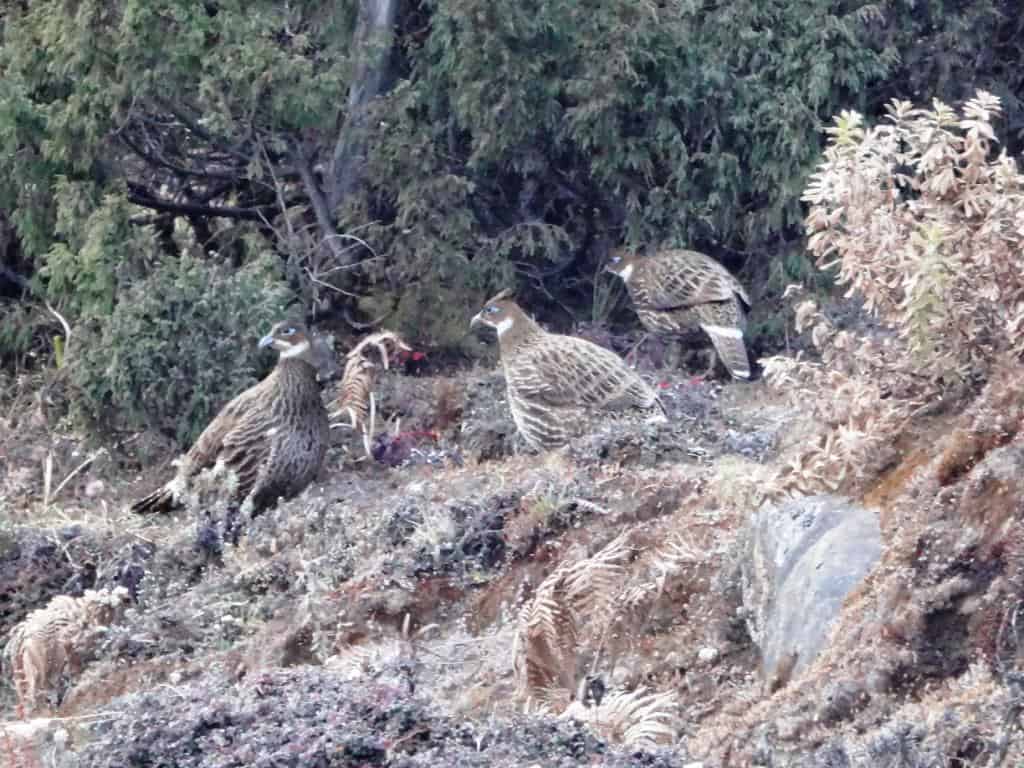
And Acccommodation: Most ‘guides’ obviously have some sort of ‘cumshaw’ deal with a hotel up front if they take you there (regardless of the cost to you)! It is just not possible for them to switch you to a closer hotel etc if you are not traveling quite so fast as they had planned. They will chivvy you along. Myself I like to just make my own way at my own pace, stopping when I am tired or when I want to. I am an old bushman and could easily have found my way to the EBC and back again by myself even if there were no road or buildings along the way – and I would prefer that sort of trip in any case. Mind you there are probably very few places you can go where the scenery is quite so stunning though!
We had no trouble walking into the first piece of accommodation we came to and securing a room for the night (usually at between US$0-2 at most) providing we ate in – we always did. Some of these guest houses were a bit ordinary but most now have solar showers (which was not the case three years ago) so you can get decently clean anytime you want to. One night coming back from Pangboche towards Tengboche we stayed (for free) at the first place we came to, the Evergreen Lodge Milinggo (Debuche). The company was pretty much all sherpas. This was the most enjoyable night of the whole trip (despite the pretty daunting toilet facilities!)
We stayed at the Lama in Lukla, the Benkar Guest House, the Shangri La in Namche, the bakery in Tengboche and the Snow Lions in Dingboche. We will be doing so again.
You can ask the manager of this night’s accommodation to ring forward and book the next night’s accommodation for you. They will cheerfully do so. If you are staying in ‘Tea Houses’ their local knowledge will be invaluable – and a saving.
In Kathmandu we always stay at the Sapana Gardens Hotel in Thamel which is very conveniently situated. The rooms and tariff are reasonable and the garden makes a lovely quiet relief from the bustle of this amazing city The business manager Ram Pyakurel is just about the most helpful person whom you will ever meet. He always goes out of his way to organise taxis, tours – anything we want, and often even accompanies us. I cannot recommend this hotel too highly.
Entering Pangboche:
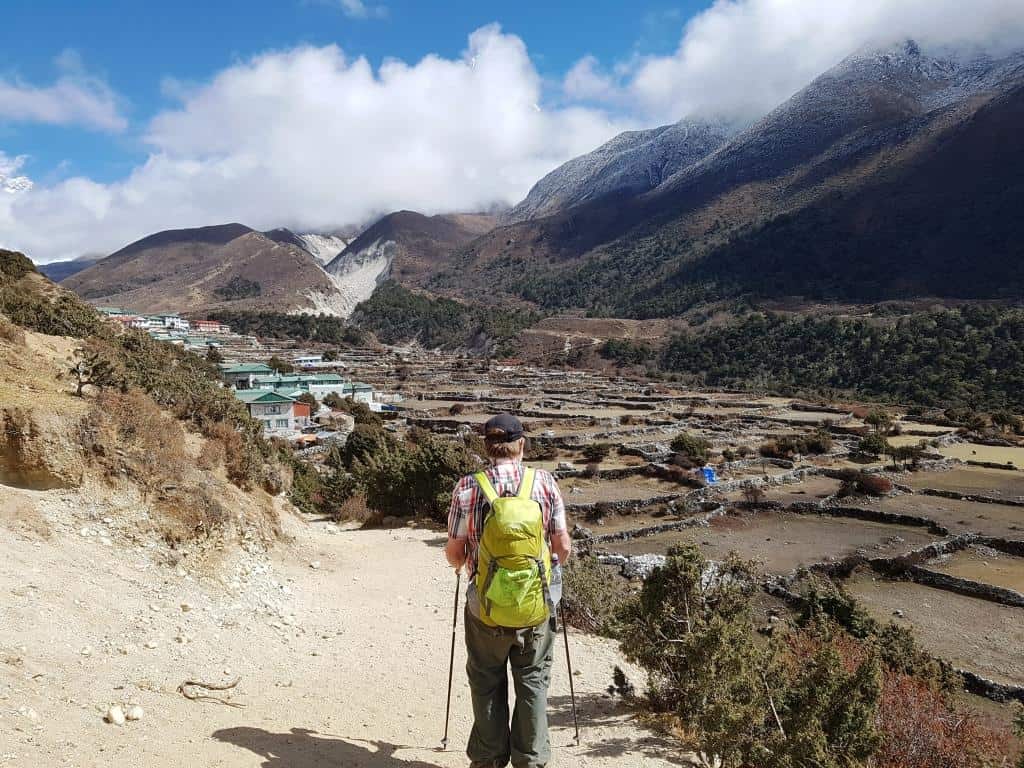
And of course if you chose to go with a guide or an outfitter you are going to have their company (and that of the rest of the awful company) all day every day for such a long time. If you are some sort of lonely misfit this might suit you, but it does not suit me. I have said many times in these pages, ‘No company is better than bad company’. Anyway, I have/had Della for company, (these last nearly fifty years) and there is no better than that!
Can you tell whether we are enjoying ourselves?
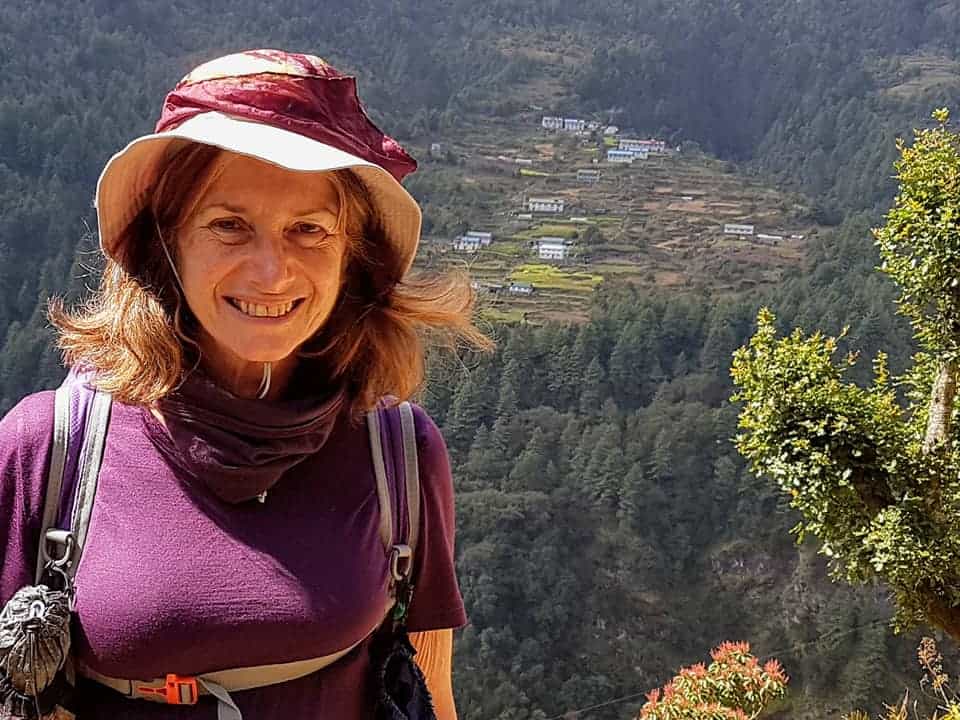
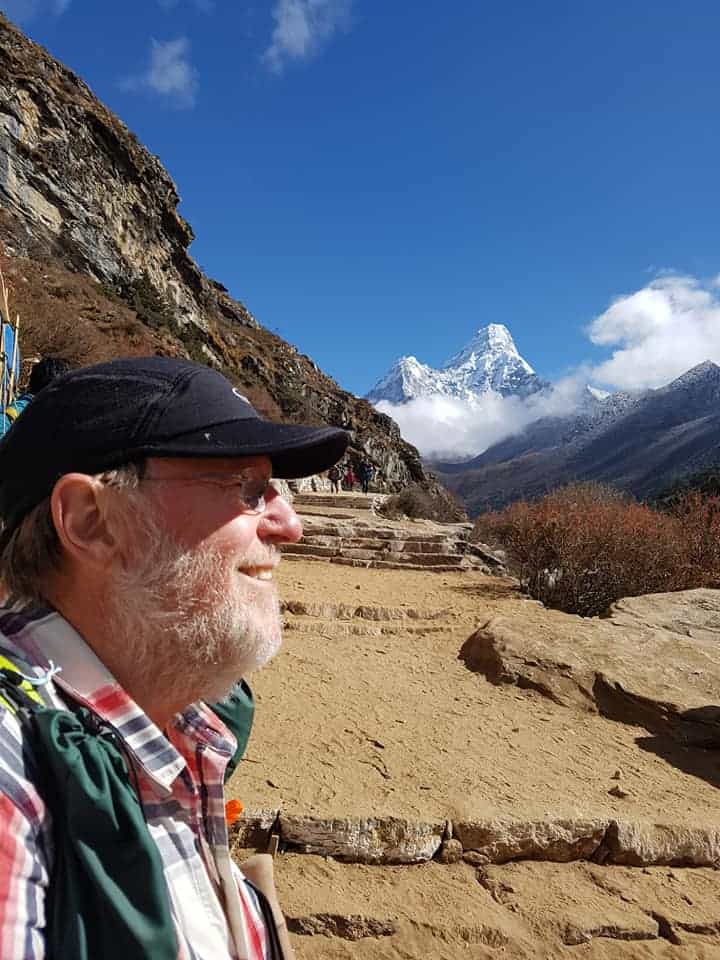
Buffs: Take something to breathe through (particularly of a night). Your throat and chest will appreciate it – and it may prevent a sore throat or chest infection. Pure Merino wool ‘Buffs’ are great. Take two. One to wash. Tip: Though you can’t hang your clothes on a line on the back of your pack, you can squeeze the wet item out as much as possible and every time you stop (lots for us) you can take it out from where you have shoved it (between your pack liner bag and your pack) and sit it in the sun while you have your break – maybe a Snickers bar? The oranges seem safe enough, but who knows what the apples have been washed in?
There is lots to see – Is Ama Dablam the most beautiful (if not the worst named of) of mountains?
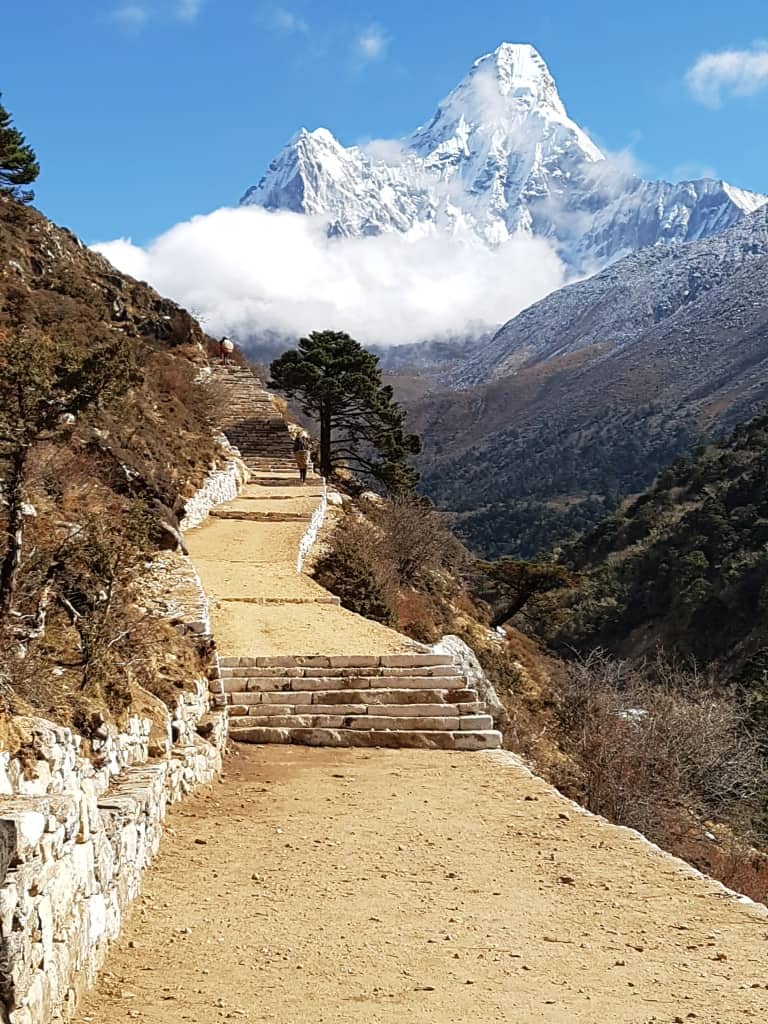
This time of year there is lots of bright sunshine (too much probably – take lots of sunscreen). They will dry quite quickly in this was – or if they are not finished you can hang them over the back of a chair in front of the fire in the guest house where you stay to finish off. This works well with towels, handkerchiefs and undies, for example – even when it is only a dung fire (common).
Take a break every now and then and smell the flowers:
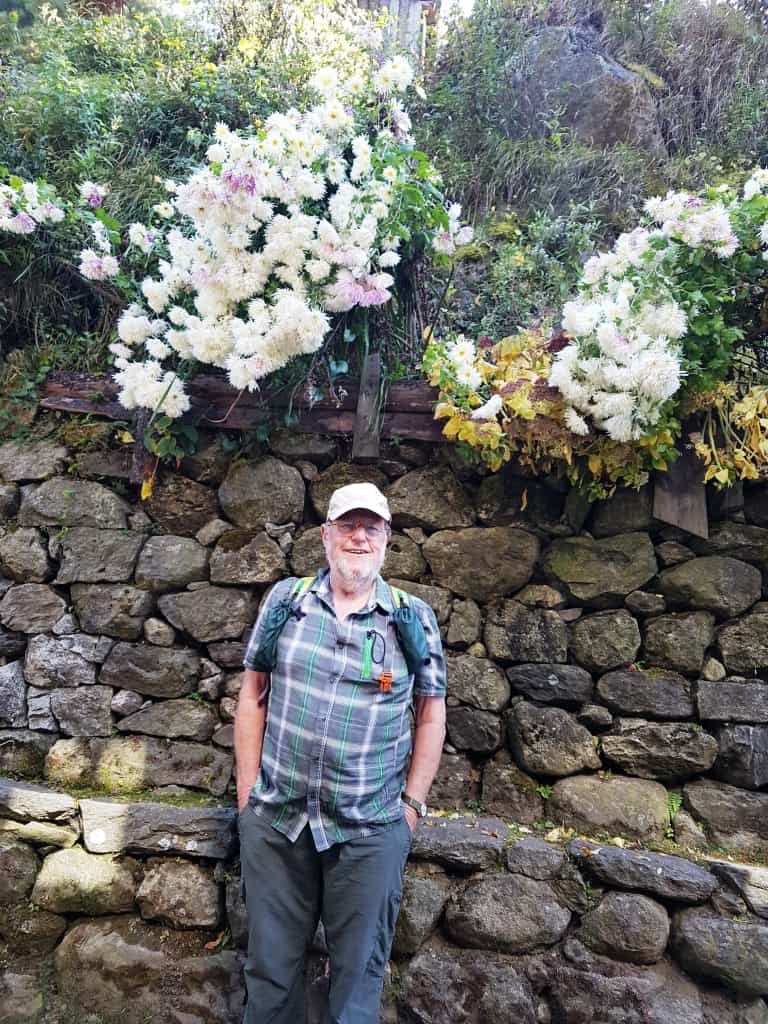
There are other devices you can use to heat up the air your are breathing it (and hydrate it). The Cold Avenger, for example. You will need to get used to them first though, I think. Most important you must never under any circumstances breathe out into your sleeping bag in order to warm it up. You will just fill it up with moisture which your body heat has then to evaporate away. You may freeze to death before you succeed!
Warm Clothes: No doubt you can underdo or overdo it in this department. I have mentioned the wonderful Montbell down garments many times before. They are our ultralight standby for warmth on the trail. I took a down vest and jacket. (Never needed the vest – but it could have been colder). Della also took her down pants. Used sometimes of a night or when she felt cold. (Not enough adipose). We both had (light) woolen shirts and Icebreaker or Kathmandu long underwear (top and bottoms). I took one bottom and two tops. Bottoms only worn (some) nights so could wash on rest days. Tops worn (sometimes) during day) and as pyjamas at night. Two pairs of Icebreaker woolen undies (one in the wash). Two pairs of medium wool socks (Darn Tough) and one pair of down socks (cold nights). I had my dyneema moccasins for a dry change. Shoes get a bot sweaty by the end of the day. Most toilet trips (nights) needed shoes on again. Water hazard! I used a Montbell sleeping bag to which we had added 9 ounces of down.
Bits and Pieces: There is mobile phone coverage pretty much all along the EBC now. You can buy a Nepalii telecom card with data for approx US$20 before you leave Kathmandu Or probably at Lukla and Namche where they sell most everything. Most guest houses etc have Wifi available for maybe US$1-2 a night. Free at Hermens Bakery Phakding where you can call your beloved on What’s App – or chat to her across the table if you are as lucky as me!
Permits: You can buy the necessary permits on the way (providing you fly in to Lukla. One permit as you exit Lukla (Approx US$20) and one when you get to Monjo (Approx US$30). it will be checked lots of times. The Nepalis are keen as mustard on bureaucracy. It is all they seem to have mastered. Otherwise they are mostly like children playing at ‘real life’. Nothing is ever organised the way you expect it would be. But the army do have some pretty fancy guns and I suspect know how to use them – and they are everywhere. Don’t know when the open season on tourists is – not when we were there anyway!
To Avoid Batteries Going Flat at High Altitude, do this.https://www.theultralighthiker.com/2019/11/17/preventing-batteries-from-going-flat-at-high-altitudes/ Yet another use for Aloksaks!
Toilet Facts: You need to get yourself prepared for the toilets – or the lack of them. Be prepared to squat. They will (likely) freeze above Dingboche. Carry handy (12) packs of tissues instead of toilet paper (and antiseptic wipes for your APC – a very important precaution). You can buy them at every town. You can clean yourself up well after a toilet stop with only 1-2 tissues. Wipe and fold, wipe and fold. You can get 5-6 wipes from a single tissue. Saves a lot of paper, weight – and does not get wet and disintegrate in the rain, etc. Carry an ultralight trowel.
What’s For Sale? You could begin the trek in a pair of thongs and a T shirt and buy everything you need along the way. Lots of shopping in Lukla and Namche, and lots of other shops with nick-nacks and groceries along the way. You can buy cans of tuna and canned ‘Spam’ in every town – if you are craving protein.
Lots and lots to see:



So we continue our journey through life: 
For more about the EBC See:
https://www.theultralighthiker.com/2019/12/14/ultralight-hiker-ebc-videos/
https://www.theultralighthiker.com/2019/12/01/ebc-gear-list/
https://www.theultralighthiker.com/2019/11/20/ebc-4-5-and-so-onwards-and-upwards/
https://www.theultralighthiker.com/2019/11/19/dos-and-donts-on-the-ebc-and-elsewhere/
https://www.theultralighthiker.com/2019/11/18/ebc-3-and-onward-to-xanadu/
https://www.theultralighthiker.com/2019/11/16/ebc-starting-out-kathmandu-to-lukla/
https://www.theultralighthiker.com/2019/11/15/9-days-trekking-the-ebc/
From my previous trip, see:
http://www.theultralighthiker.com/to-the-roof-of-the-world/
http://www.theultralighthiker.com/i-followed-my-footsteps/
http://www.theultralighthiker.com/i-saw-below-me-that-golden-valley/
http://www.theultralighthiker.com/thatendlessskyway/
http://www.theultralighthiker.com/the-diamond-desert-everest-base-camp-trek-8/
http://www.theultralighthiker.com/everest-base-camp-three-passes-trek/
http://www.theultralighthiker.com/cold-weather-face-masks/
http://www.theultralighthiker.com/my-life-was-wide-and-wild-and-who-can-know-my-heart/
https://www.theultralighthiker.com/2016/12/26/the-diamond-desert-everest-base-camp-trek-8/
